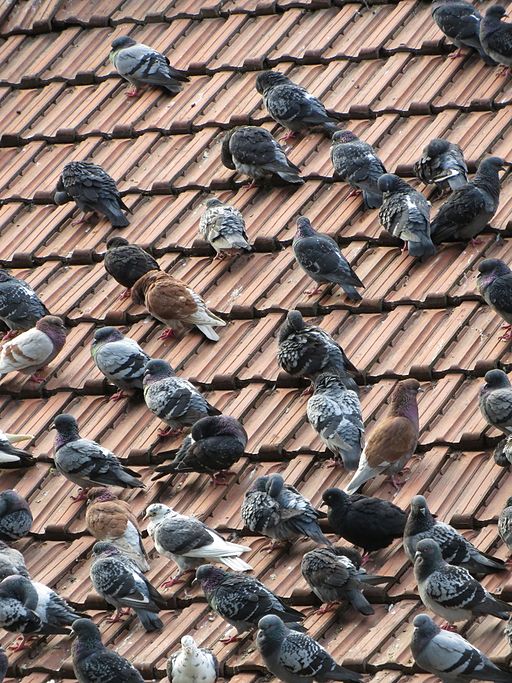Majestic birds or rats with wings?
The ubiquitous city pigeon may not deserve its bad reputation
Abigail Fagan • November 25, 2016

Pigeons mixing with their urban environment, the topic of a recent panel discussion at the Brooklyn Historical Society. [Image credit: Wikimedia user Branko Radovanović | CC BY 3.0]
When Duke Riley was nine years old, he rescued a pigeon and brought it back to his home in Bourne, Massachusetts. Although his mother made him get rid of it, the pigeon kept coming back. He ran away from home at 16, and while sleeping on the New York City streets formed a strong connection to pigeons, thinking of them as his protectors in their large, shared home. Three years later he found shelter in a pigeon coop, bunking with avian roommates for five years. As an artist today, Riley loves caring for his 600 pigeons on his Brooklyn rooftop.
Pigeons are like that: They tend to bring out strong emotions in people who live with them. As one of the few large animals that shares our urban habitat, the pigeon is often denigrated as a dirty, unpleasant pest, or a “rat with wings.” But it turns out that people didn’t always have that perspective.
A panel of four pigeon-loving experts, self-proclaimed “pigeon all-stars,” spoke Nov. 7 at the Brooklyn Historical Society, revealing that pigeons are fairly intelligent animals with a fascinating history.
“Pigeons are one of the city’s most reviled, beloved, misunderstood creatures,” said moderator Margaret Mittelbach, an environmental studies professor at New York University and founder of The Secret Science Club.
The event was part of the “Our Pesky Neighbors” series, which explores the relationship between New Yorkers and urban animals like rats, cockroaches and, of course, pigeons.
For 6,000 years, people domesticated and bred pigeons as allies. Some cultures revered them for their fertility. Others bred young pigeons as a culinary delicacy called squab. And perhaps most of all, people appreciated their ability to ferry messages over long distances — a vital service in the pre-electronic age. Homing pigeons can be released up to 800 miles from their nest and reliably return to it with a message — flying for up to 18 hours without stopping.
“I don’t know how they make it back, but they do. Like a laser-guided missile,” said Andrew Blechman, author of Pigeons: The Fascinating Saga of the World’s Most Revered and Reviled Bird.
Ancient Egyptians used pigeons to shuttle messages about flood levels up and down the Nile River, Blechman said. In 1815, pigeons relayed news of Napoleon’s defeat in the Battle of Waterloo to England and France. In World War I, a fabled pigeon named Cher Ami helped save stranded American troops, the Lost Battalion, from friendly fire when no other modes of communication were available. Cher Ami completed her journey despite being shot multiple times, resulting in a broken chest plate and dangling leg. She was given a medal for her service.
“They’re gentle creatures. They’re monogamous and great parents. I kind of think of them as kittens and puppies,” Blechman said.
They’re also smarter than people realize, as numerous studies have shown. For instance, pigeons can recognize words compared to non-words: when scientists showed pigeons the letters VERY or VREY, for example, they recognized that VERY was correct, pecking at the right word on a screen to be rewarded with food. Pigeons made the front page of the New York Times a few years ago when researchers taught pigeons to arrange numbers in increasing order, the first time that a non-primate showed abstract math skills. And the birds can even distinguish between cubist and impressionist artwork, said panelist Colin Jerolmack, a sociologist at New York University and author of The Global Pigeon.
“I believe they’re brilliant, and I’m not exaggerating. I’m very proud of these birds,” said Rita McMahon, founder of the Wild Bird Fund, an organization that rehabilitates sick birds and releases them back into the wild.
Despite all of these impressive traits, a few factors contribute to the poor reputation pigeons have nowadays, Jerolmack said. After World War II, better technology rendered pigeons’ messaging services unnecessary. Then in the 1960s and 1970s, the incorrect idea gained favor that pigeons spread diseases like meningitis, despite epidemiologists’ views that pigeons are harmless. And finally, we generally don’t want undomesticated animals to infringe upon the landscape we’ve built for ourselves. But since pigeons naturally perch on cliffs and ledges, they feel right at home resting on our apartments and park benches.
So is there any hope of improving the pigeon’s reputation? The passionate panelists seem to have won over the crowd in Brooklyn. “I’m sold on pigeons,” said attendee Lori Stover. “Everyone says ‘bird-brained’ so we assume an association between birds and low intelligence, but actually they’re super smart. Who would have pictured that?”
1 Comment
A confused pigeon unable to fly became my house-guest for a night. I slept in a chair and the pigeon slept on my chest under a blanket. The next morning she flew away and I’ve been in love with birds ever since. I am not surprised when I read about how intelligent pigeons are. I’ve no doubt they are as intelligent as humans.